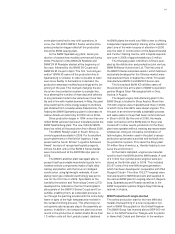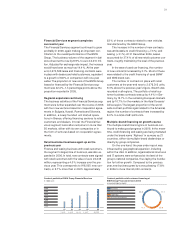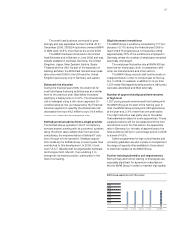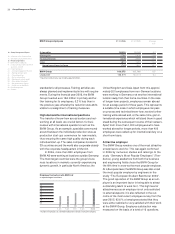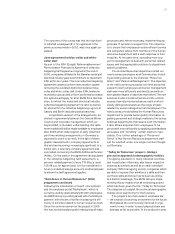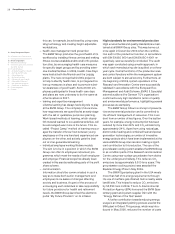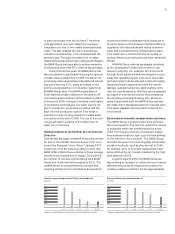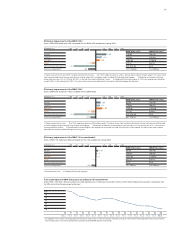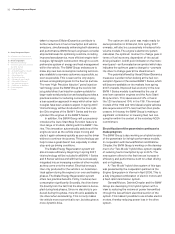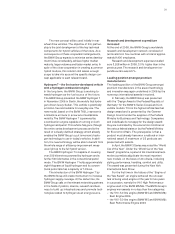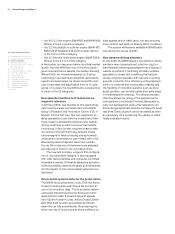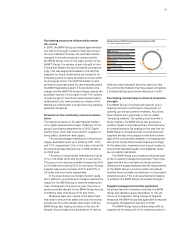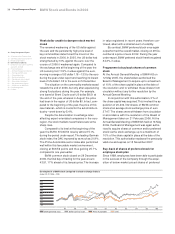BMW 2006 Annual Report Download - page 30
Download and view the complete annual report
Please find page 30 of the 2006 BMW annual report below. You can navigate through the pages in the report by either clicking on the pages listed below, or by using the keyword search tool below to find specific information within the annual report.
29
Volatile organic compounds (VOC) per unit produced
(kg/unit)
3.25
3.00
2.75
2.50
2.25
2.00
*Variance to reported figures from previous years due to larger basis of data
***
02
3.23
03
2.88
04
2.26
05
2.07
06
2.04
Process effluent per manufactured car
(m3/unit)
1.00
0.90
0.80
0.70
0.60
0.50
*Variance to reported figures from previous years due to larger basis of data
***
02
0.92
03
0.98
04
0.83
05
0.76
06
0.67
of paint necessary from four to three.The primer
coat application and oven stage has now been
integrated into one of two newly developed
base
coats.This also enabled the use of solvents per
vehicle to be reduced by 1.4% compared with
the
previous year. Through innovative use of water-
based and powder-based clear coating technologies,
the BMW Group has been able to reduce emissions
of solvents by more than 50% over the last ten years.
During the last five years, the BMW Group has
also succeeded in significantly reducing the amount
of waste water created. Since 1996, the amount of
processing water required per manufactured vehicle
has gone down by 47%, partly as a result of the
continuous development of circulation systems at
all BMW Group sites. The BMW engine plant in
Steyr reached a major milestone in the area of effi-
cient waste water treatment and circulation systems
at the end of 2006. Using an innovative combination
of membrane technologies, the
water used in the
plant’s production processes is purified and fed
back into the production system.This made it
possible to close off the production’s
waste water
connection at the end of 2006. The use of this tech-
nology will lead to a saving of 30 million litres of
water p.a. in the future.
Implementation of the EU End-of-Life Vehicles
Directive
Over the last few years, a network of recovery centres
for end-of-life vehicles has been set up in the coun-
tries of the European Union. Since 1 January 2007,
customers in the EU have been able to return their
BMW, MINI or Rolls-Royce vehicles to these recovery
centres to be recycled free of charge. During 2006,
the number of recovery centres taking back BMW
Group end-of-life vehicles increased by 23%. The
establishment of a comprehensive recovery and
recycling infrastructure in the Eastern European EU
countries involved considerable efforts because of
the short space of time between implementation of
regulations into national law and having to demon-
strate that a comprehensive network was in place.
This is also due to the fact that the necessary re-
cycling infrastructure had previously been extremely
limited.
All BMW Group vehicles are already optimised
at the development phase with a view to sub-
sequent recycling. For example, all components
through which liquids will flow are designed in such
a way that operating liquids, such as oil, fuel, brake
fluid and coolant can be emptied quickly and easily.
All pyrotechnical components within the vehicle
(airbags, seat belt tensioners, safety battery termi-
nals, etc.) are designed so that they can be released
by means of a central connector, thus simplifying
the recycling process and saving time. Moreover,
many components built into BMW Group vehicles
are made with materials derived from recycled parts.
This saves valuable resources and conserves the
environment.
Environment-friendly transportation solutions
The BMW Group’s environmental care activities
also cover logistics. The aim is to reduce the volume
of pollutants which are emitted along the entire
chain, from the procurement of materials, supply
lines between locations, right up to the final delivery
of the vehicle to the customer. The BMW Group
therefore focuses on more ecologically sound trans-
portation methods, such as ship and rail. In 2006,
for example, 32% of over-land transportation was
accomplished by rail, thereby maintaining the high
level attained in 2005.
Logistics experts within the BMW Group are
also working on a project to reduce the use of wax or
adhesive foils currently employed to protect the
outside surfaces of vehicles. In total, approximately


